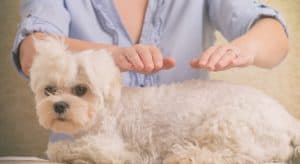Amongst the behavioral reasons why dogs are surrendered to animal shelters is a concept called Canine Rivalry.
In a nutshell, Canine Rivalry is when 2 or more dogs who live in the same house get into repeated, scuffles and conflicts. Often times these conflicts can sound quite severe with growling and teeth bearing and treacherous sounding vocalizations.
These conflicts can also look very dramatic complete with raised hackles, stiff body form and lunging. But funny, with canine rivalry ultimately, no injury occurs.
In the case of conflict over rivalry, dogs are disciplining one another or asserting authority over one another. The average dog owner does not see it this way.
Understand Origins Of This Behavior
The dog owner often times views this purely as a matter of their dogs not liking each other or fighting due to being incompatible. They conclude that the only way to end this fighting is to bring one of them to the animal shelter. However. If the owner understood the origins of the behavior, this could possibly create a solution for all concerned.
It could be a solution that would not involve surrendering one of the dogs to the pound. This article does not provide detailed solutions but instead we hope to provide you with some tips to point you in the right direction. It is not meant to train rather explain the phenomena of Canine Rivalry.
Dogs Live In A Hierarchy
Simply put, dogs do not live in a democracy like us humans. Their social structure is known as a hierarchy.
The most dominant dog in that hierarchy is in control of over all of valued resources. These things include food, toys, warm resting places and even getting attention first from the owner.
Who Becomes The Leader Of The Pack
Who becomes the leader of the pack amongst the dogs in your home is determined by the dogs and their personalities. Not by a vote, not by good looks and certainly not by their owner!
There are times when a personality shake up can cause confusion in the pack dynamic. This is typically a time that Canine Rivalry and hence conflict may occur.
Example One
For example, just because a new puppy might come in the house doesn’t mean the older dog will continue be in charge. If the puppy grows up and has a very dominant personality he may become Top Dog.
Example Two
Another example might be if lead dog became a senior and suddenly had trouble maintaining his dominant standing. Another dominant dog in the household may try to take lead position.
Example Three
An obvious situation for Canine Rivalry would be if a dominant adopted dog were to come into the new home. He may immediately attempt to assert that authority over other household pooches.
All three are examples of how a shake up in the pack structure could create a situation where there is a power struggle for ‘top dog’ positioning. Canine Rivalry would ensue
Humans Cannot Determine Hierarchy
Humans cannot determine the hierarchy. They cannot decide which dog is in charge out of the two or three or more dogs that live in the household.
Owners who do not understand this can actually create lots and lot of conflicts between their pets! Or at the very least exacerbate the situation.
Examples of Canine Rivalry Fueled By Human Behavior
Here are some examples of Canine Rivalry being fueled by human behavior.
Owner’s Favorite
For example, sometimes an owner might have a dog who’s ’their favorite’. They give the flavored dog treats first or put his leash on first to go out to play.
If that favored dog is not the leader, it’s going to cause canine rivalry, hence conflict between dogs.
The lead dog will feel the need to ‘discipline’ the subordinate dog for ‘going first’, by growling and snipping at him. Similarly this happens when owners try to treat their dogs equally; as if it were democracy.
Owner Ignores Pecking Order
When the owner ignores the ‘pecking order’ conflict will ensue.
Another example of owners being the actual cause of Canine Rivalry would be when they discipline the ‘top dog’ for expressing the right to ‘go first’. Scolding the ‘top dog’ after he asserts himself with a pack member (ie being pushy, bearing teeth, snipping) undermines his authority. This usurps the authority of the dominant dog and will ultimately perpetuate conflict.
Tips That May Help
As has been explained, human interference in the dog on dog relationship can be the reason or contributor for canine rivalry.
Also the personality dynamic amongst the dogs in the household can be the cause for the conflict. This article isn’t meant to train away the issues but just explain. However here are some tips that may help point you in the right direction. Remember, if you can find a logical reason for a behavior problem, then you can find a way to control the behavior.
Merely understanding this phenomena of Canine Rivalry will allow owner to REFRAIN from doing the following.
Don’t Play Favorites
Don’t… ‘Play Favorites’, Treat dogs as all equal, give affection food or other privileges due to size, age or any other factor (unless it supports the leader), Disciplining the dominant dog for doing what ‘comes naturally’.
Do Not Think You Can Choose The Leader
Also do not think you can ‘Choose the leader’, the dogs compete and ultimately decide this issue. It is canine instinct.
These easy to follow tips in and of themselves may control the Canine Rivalry issues in your household. Some additional guidance can also be very helpful.
Everyone To Follow Advice
Make sure all family members follow the above advice.
Figure Out The Social Structure Of the Dogs In Your Household
Once you have eliminated human interference, figure out the social structure of the dogs in your household. Who’s the boss? Who’s number 2 on the totem pole? Who’s number 3? Etc.
With this information in hand, have everyone in the family do the following:
Support The Alpha!!
This is probably one of the most important things you can do. Allow him to go first in always in all ways. The top dog receives affection, toys, treats, all valued resources first.
Do Not Get Involved In Minimal Squabbles
Next, do not get involved in minimal sibling squabbles. Allow the top dog to discipline the subordinate dogs in the house on these issues of valued resources. Do not support the subordinate dog by elevating his status in the view of the dominant dog.
Understand Canine Body Language
Finally, it would be helpful to have the family better understand Canine Body Language . This will help you better interpret the signs of dominance and submission in dogs. It will also allow you to have a better understanding of these ‘scuffles’ that your dog’s may get into.
Seek Help from Professional if Rivalry More Complex
Help from a behavior counselor can also be helpful if the rivalry is more complicated. They can offer behavior modification methods.







